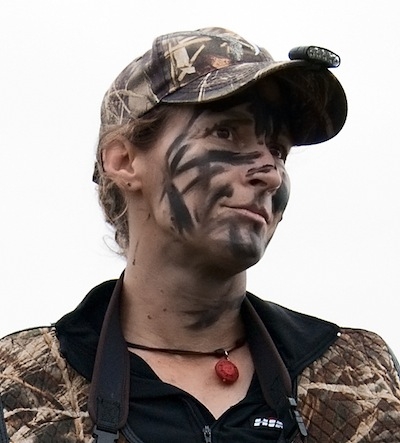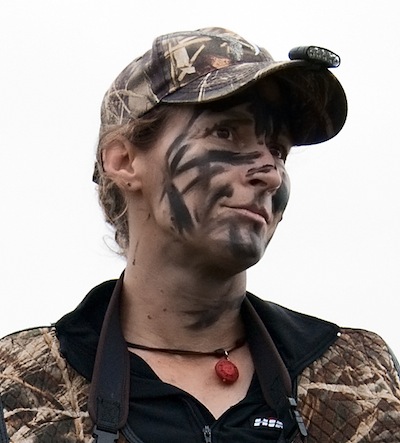I live in Ground Zero for lead bans. First, California banned much – but not all – hunting with lead in the California condor range, which is about a fifth of the state, effective in 2008.
Author: Holly A. Heyser
My Bird of Regret: the Pukeko
When you hunt strange birds in a foreign country, there’s this inescapable regret that accompanies your departure: As you pack your shotgun, you wish you would’ve tried to hunt that one beguiling bird just one more time. At the airport, you search for overpriced souvenirs with the bird’s likeness. And before you even land at LAX, you’re no longer confident you can remember what the bird sounded like, much less imitate it for the friends eagerly awaiting your tales.
Sluicing, Baiting, Wanton Waste and Other Duck Hunting No-nos
The boyfriend and I just got back from one of those hunting trips of a lifetime: We spent 11 days in New Zealand on an exchange program hunting lovely paradise shelducks, a beautiful shrieking rail called a pukeko, and alarmingly large black swans.
Counting My Ducks
Last duck season was my best ever: I was a pretty good shot most days, and I got to hunt in some great locations on some great days, so I killed 120 ducks and geese.
Holly and the Ninja
“You’re gonna hate this part,” I warned Ninja.
My 19-year-old co-worker – nicknamed for her ability to get anything done efficiently and well – immediately began to cringe and squeal, which was exactly what I wanted.
Not to be Outdone – A Duck Hunting Tale of Twisting Regrets
It had been a very good duck hunt. Clear, bright December day. Sky swept clean by a raging north wind. And at this particular spot in a small marsh surrounded by grazing cattle, we were where the birds wanted to be.
Follow the Yellow Brick Road
Oh, no. It was happening again.
When I first started getting the hang of duck hunting, it never failed: If Hank was having a good day of shooting, I would be shooting atrociously. And if I was having a good day, he couldn’t hit a damn thing.
Women Duck Hunters: Growing in Numbers, but Lagging in Independence?

This is my ninth season of duck hunting, and while the number of women duck hunters here in the Sacramento Valley has grown a lot since I got started, I’ve realized this season that we, as a class of hunters, have some work to do.
Two epiphanies have driven this train of thought.
The first was in October, when I went on a women’s hunt at the Tule Lake National Wildlife Refuge, up on the high-desert border between California and Oregon. I hunted that day with three women and a kid, all of whom I’d just met.
Two of the women were experienced waterfowlers, but I was the only one blowing duck calls. One was comfortable only with a honker call. The other – Megan, whom I count today as a dear new friend – gave up on calling years ago in the face of her brother’s ridicule.
For some reason, this day crystallized eight years of personal observation: Most women duck hunters I’ve encountered don’t call at all, use only whistles, or call only when no one else is around. Often, those women tend to disparage their own calling skills.

Holly Heyser
Obviously, there are exceptions, but there was no denying the cumulative weight of the anecdotes: Whether we’ve been picked on or are just scared to blow a bad note (which doesn’t seem to stop some incredibly bad male callers I’ve heard), we tend to leave the calling to others.
This epiphany had some very cool ripple effects, which I’ll come back to after Epiphany No. 2:
In November, I traveled 12 hours with a female coworker to hunt mallards over flooded corn in Eastern Washington – the subject of last month’s Butt, Belly, Beak, Bang. Before I left, my boyfriend Hank had been on a hunting/cooking trip to Texas, and at some point he was telling the guys there that I was going on an out-of-state duck hunt without him the following week.
One guy’s glowing reaction: “I want one!”
I’ve heard that plenty. While some troglodytes still exist in duck hunting, most men I’ve met would love it if their wives and girlfriends were into duck hunting as much as they were. Or at all.
But that wasn’t what this guy meant. Hank explained they were all blown away that I would go on a hunt that far away without him.
I’m pretty sure I cocked my head and furrowed my eyebrows at Hank when he said this, much the way our cat Harlequin looks at us when we’re eating something yummy and she can’t figure out why we aren’t sharing.
You see, in this case, this experience did NOT square with eight years of personal observation. My circle of duck hunting friends and acquaintances here in Northern California includes a bunch of women who frequently hunt without their significant others, in several cases because their significant others don’t hunt.
I chewed on that story all the way up to Washington, and the night after our first hunt, I told my hunting partner, Regina, about it. She had the same reaction I did, so we decided to test the women-don’t-hunt-without-their-men hypothesis on our guide, Mike Franklin, the next morning.
During a rare lull in the shooting – maybe a full minute or even two without ducks working – I turned to Mike. “I’ve got a two-part question for you, Mike.”
“OK?” he said slowly, maybe just a bit taken aback by the formality.
“One, how often do women hunt with you up here, and two, how often do they come up here without their boyfriends or husbands?”
He answered quickly. “Rarely, and never.”
We were blown away. Regina and I were his first unaccompanied female hunters! And he’s not a newbie – he’s been guiding for decades.
Is my circle of intrepid gal-pal duck hunters in NorCal that unusual?
I’ve met enough women duck hunters around this country to know we are not unique. But we might still be on the rare side, and I’m uneasy with that. It’s not that I think women should hunt ducks exactly the way men do; I think I’m just really bothered by the timidity implicit in all of this. It’s 2015. We should be way beyond timid by now.
It reminds me of something my friend Dana asked me on my very first hunt with her, in my second season of duck hunting. We were clinging to hot cups of tea and coffee while we waited for shoot time, sitting in a blind along a river. This was our get-to-know-each-other hunt, and Dana had already established that I was more than a bit bonkers about duck hunting.
“OK, here’s a question,” she said. “If you lost Hank for some reason – God forbid! – would you still hunt?”
I didn’t hesitate.
“Oh yeah. And if he left me, there’d be a fight over the decoys.” It was the answer Dana was looking for.
I may be asking a similar question of other women duck hunters down the road. Would you go on a big duck hunting trip without your husband? Even if the real answer is no, I hope something stops them from saying it long enough to at least consider the possibilities.
Now, I promised to tell you about the ripple effects of Epiphany No. 1.
I left that hunt in October thinking hard about my own calling, how I’d never considered my calling good enough to invest in a quality mallard call. Yep, I’m insecure too. So I ordered a good call that several of my (male) hunting friends liked: the Zink Green Machine.
Then I bundled up a bunch of my starter calls and shipped them up to Megan, and ordered her a copy of Zink’s “Mallards Gone Wild” CD, which has lengthy recordings of mallards that you can “sing along” with. That CD was what had finally given me the courage to blow a mallard call a couple years ago in the first place.
When I told Megan the package was on its way, she gave her old call – the one she’d given up on – to the kid who’d gone with us on the women’s hunt back in October.
Around the same time, I told a board member of the non-profit I work for about the whole series of events, and how excited I was to be taking my calling more seriously. Craig has been a calling contest and call-makers contest judge, so I figured he would understand this was an important moment for me.
Apparently he did. A few days later, I received a package from him: He was giving me one of his custom JJ Lares calls, along with extra reeds that would increase the difficulty of using the call, but also the quality.
I recognized immediately it was a very generous gift, and the wide eyes of everyone else who’s seen that call on my lanyard since then confirms it.
There’s a message here: Nothing about our state as female duck hunters is permanent. Everything can change.
Sometimes all it takes is someone telling you, “Hell yes, you can do this. Now get going!”
Holly A. Heyser is the editor of California Waterfowl Magazine. A hunter, forager, writer and photographer, she lives in Sacramento, California. You can see more of her work at hollyheyser.com
The Hunt that Couldn’t Possibly Be as Good as Advertised
My boyfriend was skeptical.
I was about to go on a hunt where I was told to expect to shoot nothing but greenheads flaps down over decoys.
“They always say that,” Hank said, “but it’s rarely the case.”
“I don’t know,” I responded. “I’ve seen video from these hunts. It looks pretty good.”
And our guide, Mike Franklin at Pacific Wings Prairie Outfitters, had juiced my anticipation with his description of carefully managed flooded corn ponds with aerators to keep the water from freezing.
Hunting the Drought: The Opening Act
In the days and weeks leading up to the California duck hunting opener, the reports from my buddy Charlie were good. The lake we hunted in his neck of the woods was filthy with puddle ducks. That would’ve been a head-scratcher in any normal year, because this was strictly a diver lake.
Shotgun Life Newsletters
Join an elite group of readers who receive their FREE e-letter every week from Shotgun Life. These readers gain a competitive advantage from the valuable advice delivered directly to their inbox. You'll discover ways to improve your shooting, learn about the best new products and how to easily maintain your shotgun so it's always reliable. If you strive to be a better shooter, then our FREE e-letters are for you.
About Shotgun Life
Shotgun Life is the first online magazine devoted to the great people who participate in the shotgun sports.
Our goal is to provide you with the best coverage in wing and clays shooting. That includes places to shoot, ways to improve your shooting and the latest new products. Everything you need to know about the shotgun sports is a mouse-click away.
Contact
Irwin Greenstein
Publisher
Shotgun Life
PO Box 6423
Thomasville, GA 31758
Phone: 229-236-1632







